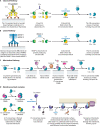Subversion of the Complement System by Pseudomonas aeruginosa
- PMID: 37436150
- PMCID: PMC10464199
- DOI: 10.1128/jb.00018-23
Subversion of the Complement System by Pseudomonas aeruginosa
Abstract
Pseudomonas aeruginosa is an opportunistic pathogen heavily implicated in chronic diseases. Immunocompromised patients that become infected with P. aeruginosa usually are afflicted with a lifelong chronic infection, leading to worsened patient outcomes. The complement system is an integral piece of the first line of defense against invading microorganisms. Gram-negative bacteria are thought to be generally susceptible to attack from complement; however, P. aeruginosa can be an exception, with certain strains being serum resistant. Various molecular mechanisms have been described that confer P. aeruginosa unique resistance to numerous aspects of the complement response. In this review, we summarize the current published literature regarding the interactions of P. aeruginosa and complement, as well as the mechanisms used by P. aeruginosa to exploit various complement deficiencies and the strategies used to disrupt or hijack normal complement activities.
Keywords: Pseudomonas aeruginosa; biofilms; complement; immune evasion; innate immunity; opsonization; persister cells; phagocytosis.
Conflict of interest statement
The authors declare no conflict of interest.
Figures
References
-
- Gaspar MC, António A, Canelas Pais C, Simões De Sousa JJ. 2013. New treatment approaches of Pseudomonas aeruginosa infection in cystic fibrosis lung disease. J Compr Ped 4:203–204. doi:10.17795/compreped-13822. - DOI
-
- Kalle M, Papareddy P, Kasetty G, Mörgelin M, van der Plas MJA, Rydengård V, Malmsten M, Albiger B, Schmidtchen A. 2012. Host defense peptides of thrombin modulate inflammation and coagulation in endotoxin-mediated shock and Pseudomonas aeruginosa sepsis. PLoS One 7:e51313. doi:10.1371/journal.pone.0051313. - DOI - PMC - PubMed
Publication types
MeSH terms
Substances
LinkOut - more resources
Full Text Sources


